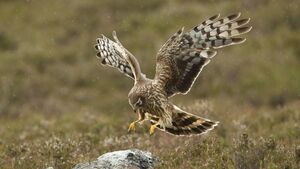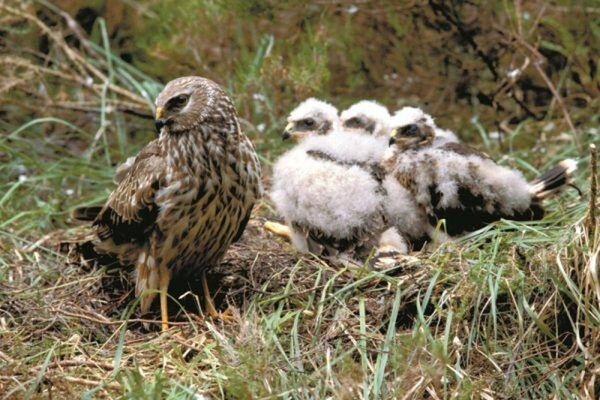Plan launched to save rare bird of prey in Laois

A striking image of an adult female hen harrier Photo: Mark Hamblin
The magnificent Slieve Bloom Mountains in Laois were the setting for the launch of a five-year plan to save a rare bird of prey from extinction.
The Hen Harrier Threat Response Plan 2024-2028 sets out a roadmap to prevent the rare native species from dying out and to improve its long-term prospects. The Slieve Blooms are among only six areas in Ireland designated as Hen Harrier special protection areas.
Launched by minister of state Malcolm Noonan at the beautiful tourist spot on 10 September, the plan includes ‘a series of co-ordinated, cross sectoral actions’ across agriculture, forestry and wind energy sectors.
Minister Noonan described the plan as “a significant milestone” in the collective effort to prevent the extinction of “our precious sky dancer”.
A ground nesting bird of prey, the Hen Harrier breeds in open upland bog, heather moorland and associated habitats. It has seen significant declines in recent years and could face extinction within the next 25 years if action is not taken.

The fifth national survey of Hen Harriers in 2022 showed that the Slieve Blooms had only nine Hen Harrier pairs, a decline of one-quarter since the 2015 survey. Only 85 confirmed pairs of Hen Harrier were recorded throughout the country, representing the most severe decline to date.
The new plan describes the particular threats faced by the rare bird and sets out a series of co-ordinated actions, including the restoration of important habitats.
The plan recognises the importance of landowners and farming communities in improving Hen Harrier habitats and the need for ‘supports and incentives’ to engage them in conservation.
Speaking at the launch, Minister Noonan said: “The plight of this iconic bird highlights the broader issues we face, both nationally and globally, in tackling the biodiversity crisis and its future is very much in our hands. It’s vital that we now focus urgently and strategically on implementation.
“We must seize the opportunities presented in this plan to deliver meaningful change to the management of our landscapes and protect our most vulnerable species.” The plan features actions to address key threats and pressures, such as land use change and climate change. The actions, which are to be taken both within Hen Harrier Special Protection Areas (SPAs




